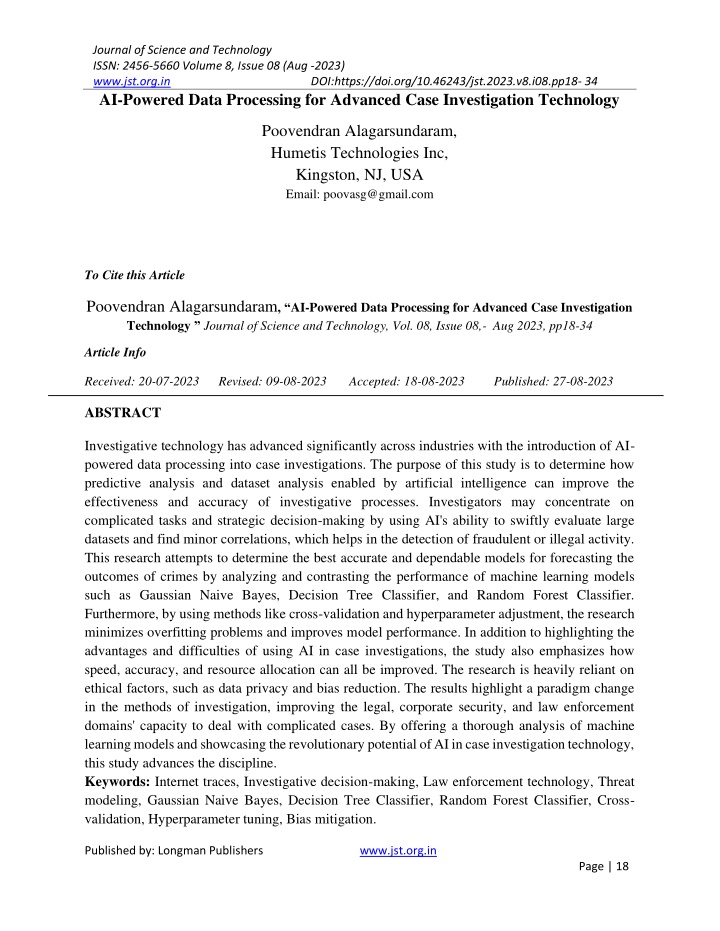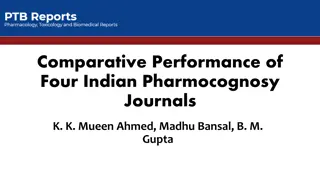
peer reviewed scientific journals
Peer-reviewed scientific journals are academic publications that feature articles which have undergone a rigorous evaluation process by experts in the field before being published. This process typically involves Submission: Authors submit their rese
Download Presentation

Please find below an Image/Link to download the presentation.
The content on the website is provided AS IS for your information and personal use only. It may not be sold, licensed, or shared on other websites without obtaining consent from the author. If you encounter any issues during the download, it is possible that the publisher has removed the file from their server.
You are allowed to download the files provided on this website for personal or commercial use, subject to the condition that they are used lawfully. All files are the property of their respective owners.
The content on the website is provided AS IS for your information and personal use only. It may not be sold, licensed, or shared on other websites without obtaining consent from the author.
E N D
Presentation Transcript
Journal of Science and Technology ISSN: 2456-5660 Volume 8, Issue 08 (Aug -2023) www.jst.org.in DOI:https://doi.org/10.46243/jst.2023.v8.i08.pp18- 34 AI-Powered Data Processing for Advanced Case Investigation Technology Poovendran Alagarsundaram, Humetis Technologies Inc, Kingston, NJ, USA Email: poovasg@gmail.com To Cite this Article Poovendran Alagarsundaram, AI-Powered Data Processing for Advanced Case Investigation Technology Journal of Science and Technology, Vol. 08, Issue 08,- Aug 2023, pp18-34 Article Info Received: 20-07-2023 Revised: 09-08-2023 Accepted: 18-08-2023 Published: 27-08-2023 ABSTRACT Investigative technology has advanced significantly across industries with the introduction of AI- powered data processing into case investigations. The purpose of this study is to determine how predictive analysis and dataset analysis enabled by artificial intelligence can improve the effectiveness and accuracy of investigative processes. Investigators may concentrate on complicated tasks and strategic decision-making by using AI's ability to swiftly evaluate large datasets and find minor correlations, which helps in the detection of fraudulent or illegal activity. This research attempts to determine the best accurate and dependable models for forecasting the outcomes of crimes by analyzing and contrasting the performance of machine learning models such as Gaussian Naive Bayes, Decision Tree Classifier, and Random Forest Classifier. Furthermore, by using methods like cross-validation and hyperparameter adjustment, the research minimizes overfitting problems and improves model performance. In addition to highlighting the advantages and difficulties of using AI in case investigations, the study also emphasizes how speed, accuracy, and resource allocation can all be improved. The research is heavily reliant on ethical factors, such as data privacy and bias reduction. The results highlight a paradigm change in the methods of investigation, improving the legal, corporate security, and law enforcement domains' capacity to deal with complicated cases. By offering a thorough analysis of machine learning models and showcasing the revolutionary potential of AI in case investigation technology, this study advances the discipline. Keywords: Internet traces, Investigative decision-making, Law enforcement technology, Threat modeling, Gaussian Naive Bayes, Decision Tree Classifier, Random Forest Classifier, Cross- validation, Hyperparameter tuning, Bias mitigation. Published by: Longman Publishers www.jst.org.in Page | 18
Journal of Science and Technology ISSN: 2456-5660 Volume 8, Issue 08 (Aug -2023) www.jst.org.in DOI:https://doi.org/10.46243/jst.2023.v8.i08.pp18- 34 1.INTRODUCTION AI-powered data processing greatly improves case investigation technologies used in today's investigating procedures. This study investigates how quick and precise dataset analysis made possible by artificial intelligence enhances investigative procedures in a variety of industries. Sophisticated machine learning algorithms examine financial documents, internet traces, and behavioral patterns to find trends and identify minute correlations that point to dishonest or illegal activity. Data analysis operations that have historically required a great deal of human labor are automated by AI, which speeds up information identification and increases dependability. Furthermore, artificial intelligence (AI) is excellent at predictive analysis. By predicting patterns and results from past data, it enables investigators to proactively counter new threats and foresee the changing strategies employed by offenders. Because AI-powered data processing automates repetitive processes like data categorization and preliminary analysis, it promotes a more strategic approach to investigative decision-making. This frees up investigators to concentrate on more advanced activities including formulating plans of action, working with interdisciplinary teams, and deciphering complex data. This change improves the efficacy of investigations and makes it possible for businesses to respond quickly to difficult instances and spend resources effectively. Investigative techniques are about to undergo a paradigm change because to AI-powered data processing, which can handle enormous datasets, forecast results, and optimize workflows. For law enforcement, the legal community, and corporate security, this technical breakthrough is revolutionary because it increases their ability to find crucial information, improve decision- making, and win cases. In order to address the complex and ever-changing concerns of today's world, this introduction lays the groundwork for examining how AI might transform case investigation technology. An important step forward has been made with the introduction of AI-powered data processing into case investigations, which has improved the efficacy and efficiency of investigative procedures in a number of industries. Automation of data analysis and assistance with human decision-making were the primary goals of AI's early adoption in this sector. Investigative teams can now handle massive amounts of complicated data with greater speed and accuracy, enabling the identification of patterns, anomalies, and correlations that are essential to case resolution. These advancements have completely changed the way investigative teams handle data. Artificial intelligence (AI)-driven systems may scan through a variety of data sources, including unstructured text and multimedia as well as structured databases, to extract actionable insights and produce predictive analytics. This is accomplished by utilizing machine learning algorithms and natural language processing techniques. This change speeds up the investigative process and enhances the accuracy and consistency of the results. AI is enabling more strategic and efficient decision-making in the legal, corporate security, and law enforcement sectors by handling large and diverse datasets, forecasting trends, and streamlining procedures. These advancements in AI constitute a paradigm shift in investigative techniques. Organizations are able to respond to Published by: Longman Publishers www.jst.org.in Page | 19
Journal of Science and Technology ISSN: 2456-5660 Volume 8, Issue 08 (Aug -2023) www.jst.org.in DOI:https://doi.org/10.46243/jst.2023.v8.i08.pp18- 34 difficult instances faster, find crucial information more quickly, and conduct investigations that produce better results. Palantir Gotham, IBM i2 Analyst's Notebook, and SAS Visual Investigator are just a few examples of the systems that have dramatically changed case investigation technology thanks to AI-powered data processing. These sophisticated tools increase productivity by reducing human labor, automating repetitive processes, and speeding up data processing. These platforms provide sophisticated visualization and increase accuracy by finding patterns among large datasets, which aids investigators in comprehending intricate linkages. They also provide predictive powers that facilitate proactive decision making. Simplifying workflows, helping teams find connections and patterns, and improving decision-making through predictive analytics and risk assessments are the main objectives of using AI into case studies. There are, however, a few difficulties with this integration. There are many obstacles to overcome, including ensuring data quality from a variety of sources, integrating AI solutions with current technologies in an efficient manner, addressing ethical issues with data security and privacy, filling in the skill shortages required for effective AI use, and adhering to legal standards. Despite these obstacles, investigative teams can manage difficult cases more precisely and efficiently by utilizing AI-powered data processing, which also optimizes resource allocation and lowers operating expenses. In addition to improving investigative results, this technology development signifies a significant change in the way investigations are carried out, enabling businesses to react to the complexity of contemporary cases more quickly and efficiently. In order to determine which machine learning model is most accurate and dependable for assisting with case investigations, this study will assess the performance of several models, such as Gaussian Naive Bayes, Decision Tree Classifier, and Random Forest Classifier, in predicting crime outcomes within a particular district dataset. Additionally, in order to guarantee consistent performance across many datasets and real-world circumstances, the research aims to improve these models' predictive accuracy and generalization skills. Through the use of methods like cross- validation and hyperparameter tweaking, the study aims to solve potential overfitting concerns and create a robust AI-powered system that enhances the effectiveness and dependability of case investigations. Even while the application of AI in case investigations has been the subject of several research, nothing is known about the relative efficacy of various machine learning models that are especially designed for crime data. The performance and generalization capacities of these models in actual research contexts are frequently not thoroughly assessed in the literature that currently exists. Moreover, little study has been done on the possible overfitting problems that can result from extremely accurate models like the Random Forest Classifier. By offering a thorough comparison analysis of machine learning models and suggesting ways to improve their dependability and practical applicability in case studies, this paper seeks to close this gap. Published by: Longman Publishers www.jst.org.in Page | 20
Journal of Science and Technology ISSN: 2456-5660 Volume 8, Issue 08 (Aug -2023) www.jst.org.in DOI:https://doi.org/10.46243/jst.2023.v8.i08.pp18- 34 Promising results have been observed in the use of artificial intelligence to case investigation technologies. However, the problem is to find the best machine learning models that can predict crime outcomes reliably without overfitting. Given their current high accuracy, models such as the Random Forest Classifier may be overfit, which could reduce their usefulness in practical applications. Thus, the goal of this research is to assess and contrast the predictive abilities of different machine learning models, put overfitting mitigation techniques into practice, and make sure these models can effectively generalize to new data. The ultimate objective is to create a reliable AI-powered system that improves case investigations' dependability and efficiency in a variety of settings. 2.LITERATURE SURVEY Liu et al. (2021) proposes that AI-powered language models significantly enhance the efficiency and effectiveness of drug discovery and development. These models can be instrumental in various stages of the process, including target identification, clinical design, regulatory decision-making, and pharmacovigilance, particularly in developing treatments for COVID-19 and other potential pandemic-causing infectious diseases. Despite their transformative impact on natural language processing and their potential in drug discovery, challenges remain that need addressing. Nonetheless, there are potential solutions to improve the utilization of AI-powered language models in this field. Ranchon et al. (2023) conducted a systematic review of 19 studies that utilized artificial intelligence (AI) in clinical pharmacy services, particularly focusing on medication order reviews. Most studies included in the review were published in 2020 or 2021 and involved hospital pharmacists. The primary goal was to identify and analyze quantitative studies integrating AI into clinical pharmacy services. The review highlighted that the predominant AI methodologies used were machine learning techniques, including natural language processing and deep learning. Despite the nascent stage of AI-powered apps and tools in this field, the study emphasized the necessity for collaborative efforts between pharmacists and data scientists to evaluate their practical effectiveness in real-world clinical settings. In their study, Niazi et al. (2023) report that in 2021, the FDA received over 100 submissions relying heavily on AI and machine learning (ML) for drug discovery and manufacturing. To ensure the safe and effective use of these technologies, the FDA and other U.S. federal agencies have issued strict guidelines. The aim is to expedite drug discovery, enhance safety profiles, and foster innovative therapies. The maturation of AI and ML represents a significant advancement in computing, expanding market opportunities and enabling novel applications in emerging therapies such as gene editing, CRISPR-Cas9, CAR-T cells, mRNA-based treatments, and personalized medicine. Illiashenko et al. (2023) explores a security-informed safety approach to assess and enhance the safety and dependability of autonomous transport systems (ATSs), including UAVs and UMVs. Published by: Longman Publishers www.jst.org.in Page | 21
Journal of Science and Technology ISSN: 2456-5660 Volume 8, Issue 08 (Aug -2023) www.jst.org.in DOI:https://doi.org/10.46243/jst.2023.v8.i08.pp18- 34 Their research integrates established techniques like FMECA and IMECA and introduces a novel method called SISMECA. This methodology involves applying and refining SISMECA, developing scenarios for cyberattacks and physical influences, and leveraging AI for system protection. The paper highlights examples of SISMECA's application and discusses AI quality models, risk-based assessments, and countermeasures to safeguard ATSs from cyberattacks, emphasizing the critical role of AI-powered protection in maintaining the security and reliability of these systems. Al Kuwaiti et al. (2023) research paper reviews the transformative role of artificial intelligence (AI) in healthcare, particularly its impact on medical imaging, virtual patient care, drug discovery, patient engagement, and administrative tasks. The paper highlights AI's potential to enhance various aspects of healthcare, yet acknowledges significant challenges related to privacy, safety, and ethical considerations. Effective governance is essential to navigate these challenges and ensure the successful integration of AI, particularly in the context of the COVID-19 pandemic. AI's influence spans medical imaging and diagnostics, virtual patient care, medical research and drug discovery, and patient engagement and compliance. However, the integration of AI introduces technical, ethical, and social challenges, including concerns about privacy, safety, costs, and efficacy. Effective governance is crucial to ensuring patient safety, accountability, and addressing regulatory, ethical, and trust issues associated with AI implementation in healthcare. Shelke et al. (2023) proposes that artificial intelligence (AI) is revolutionizing microbial diagnosis by enhancing disease management, drug development, and the prediction of antibiotic resistance. AI systems are capable of rapidly and accurately detecting infections, including new and drug- resistant strains, which facilitates early identification of antibiotic resistance. The primary focus of AI in this field is on improving the speed and precision of pathogen identification and predicting antibiotic resistance. This technological advancement not only improves diagnostic techniques but also supports better epidemiological monitoring. Through these capabilities, AI significantly contributes to the timely and precise management of microbial diseases. Xu et al. (2023) research paper explores the application of artificial intelligence (AI) in the development of electronic skin (e-skin) technology, which enables continuous and non-invasive monitoring of physiological and biochemical data. The paper highlights recent advancements and potential applications of AI in engineering e-skins, alongside an analysis of the challenges and future prospects in this field. It is noted that next-generation e-skin will leverage AI to enhance design and generate user-personalized health profiles, with multimodal e-skin platforms already employing machine learning algorithms for autonomous data analysis. The review also delves into the current obstacles and future directions for AI-powered e-skins, projecting the evolution of smart e-skin technology. Husnain et al. (2023) proposes that artificial intelligence (AI) is increasingly integrated into drug discovery processes to enhance efficiency and success rates. They discuss AI's diverse applications, including target identification, virtual screening, and drug design, highlighting its Published by: Longman Publishers www.jst.org.in Page | 22
Journal of Science and Technology ISSN: 2456-5660 Volume 8, Issue 08 (Aug -2023) www.jst.org.in DOI:https://doi.org/10.46243/jst.2023.v8.i08.pp18- 34 potential to revolutionize drug delivery systems and significantly impact healthcare. The paper explores AI's historical evolution in medicine and outlines future directions. It underscores the challenges in traditional drug development its expense, time-consuming nature, and high failure rates emphasizing AI's role as a transformative tool poised to optimize these processes. Reddy et al. (2022) highlights the significant advancements of artificial intelligence (AI) in the medical field, particularly in its ability to rival clinical physicians in analyzing medical images and records. Their review focuses on AI's application in prenatal diagnosis of congenital heart disease (CHD), addressing imaging, genetic diagnosis, and risk prediction while proposing solutions to current limitations. The unique challenges presented by fetal conditions and the complexities of cardiac anatomy drive active research into AI's role in CHD diagnosis. The review delves into the clinical inquiries and research methodologies employed, underscoring AI's transformative potential in enhancing diagnostic accuracy and prognostic capabilities in prenatal care. Piraianu et al. (2023) explores the integration of artificial intelligence (AI) in forensic medicine and pathology, highlighting its potential to enhance accuracy and efficiency across various applications such as forensic identification and post-mortem interval estimation. AI algorithms are leveraged for data analysis, pattern recognition, anomaly detection, and decision-making processes within these fields. A comprehensive review of 113 articles underscores AI's successful applications in forensic medicine, encompassing areas like ballistics, traumatic injuries, forensic toxicology, and more. While promising, the adoption of AI in forensic contexts faces challenges, including ethical considerations and data security concerns that necessitate careful attention. Piraianu et al. advocate for ongoing research and technological advancements to fully harness AI's transformative capabilities in forensic settings. In their proposal, Wankhade et al. (2022) explores the transformative potential of artificial intelligence (AI) in forensic medicine and toxicology, envisioning its role in revolutionizing processes like autopsies, sample analysis, and crime investigations. They highlight AI's capacity to enhance speed and accuracy in these procedures, foreseeing it as a pivotal component of future practices. Emphasizing AI as akin to the next Industrial Revolution across all industries, they underscore its promising implications for forensic medicine and toxicology, crucial for crime investigation and poised for substantial development. AI is positioned to address limitations inherent in traditional autopsy and opinion formulation methods, offering significant advancements in toxin analysis, sample collection, and detection of weapons and bodily stains within forensic medicine protocols. In their research, Pasha et al. (2022) focuses on leveraging artificial intelligence (AI) systems and models for detecting and combating cybercrimes targeting children in Pakistan. They emphasize the increasing incidence of such crimes due to heightened internet usage in the country. The study reviews current literature and proposes the implementation of AI-enabled software and models to effectively identify and mitigate indecent activities against minors. Highlighting the success of AI technology in this domain, the paper underscores its role in aiding law enforcement agencies by Published by: Longman Publishers www.jst.org.in Page | 23
Journal of Science and Technology ISSN: 2456-5660 Volume 8, Issue 08 (Aug -2023) www.jst.org.in DOI:https://doi.org/10.46243/jst.2023.v8.i08.pp18- 34 enhancing investigation capabilities and managing cybercrime-related data. Additionally, policy recommendations are provided alongside discussions on the limitations inherent in these AI applications. 3.METHODOLOGY In order to improve case investigation technology, this part describes the thorough approach used in the research. The research focuses on utilizing AI-powered data processing. A review of the literature, threat modeling, dataset analysis, machine learning model evaluation, and model optimization are all part of the methodical methodology used in this research project. To guarantee the dependability, precision, and usefulness of AI-driven solutions in actual investigation situations, each stage is meticulously designed. 3.1. Analysis of Literature To acquire fundamental knowledge about the status of AI in case investigations, security protocols, privacy problems, and threat modeling approaches, the research starts with a thorough assessment of the literature. Scholarly articles, conference papers, technical reports, and trade periodicals must all be thoroughly searched and analyzed. This phase's goals are as follows: Determine Today's Trends: Comprehending the most recent developments in artificial intelligence applications in case studies. Finding clear knowledge gaps in the field, especially when it comes to contrasting and evaluating various machine learning models for the analysis of crime data. Clarify Important Difficulties: Identifying the key challenges that investigators have when using AI technologies into their processes. The goal of the study is to provide a strong theoretical framework for the further stages of the investigation by combining the data that has been collected. 3.1.Threat Modeling Constructing a complete threat model specifically for Vehicular Cloud Computing (VCC), the work builds on findings from the literature review. In order to perform this stage, possible threats and attack vectors in VCC environments must be methodically identified and categorized. To examine and evaluate the range of risks, well-known threat modeling approaches like CIAA (Confidentiality, Integrity, Availability, Accountability) and STRIDE (Spoofing, Tampering, Repudiation, Information Disclosure, Denial of Service, Elevation of Privilege) are used. This table 1 aims to accomplish the following: Published by: Longman Publishers www.jst.org.in Page | 24
Journal of Science and Technology ISSN: 2456-5660 Volume 8, Issue 08 (Aug -2023) www.jst.org.in DOI:https://doi.org/10.46243/jst.2023.v8.i08.pp18- 34 Threat Category Spoofing Description Obtaining illegal access to VCC systems by fabricating cloud service login credentials or vehicle identities. Unauthorized changes to software or data in VCC systems have the potential to compromise or malfunction the system. denying participation in transactions or harmful activity within VCC systems, making traceability and responsibility more difficult. Unauthorized access to or disclosure of private or sensitive data, including vehicle identification and location data, jeopardizing security and privacy. Flooding malicious requests or traffic into VCC systems, causing outages or disruptions to genuine users' access. Gaining access to important functions or data without authorization by abusing security holes in VCC systems to increase user privileges. Tampering Repudiation Information Disclosure Denial of Service (DoS) Elevation of Privilege Table 1: Hazards and Attack Routes Recognized in Vehicle Cloud Computing (VCC) Environments. Published by: Longman Publishers www.jst.org.in Page | 25
Journal of Science and Technology ISSN: 2456-5660 Volume 8, Issue 08 (Aug -2023) www.jst.org.in DOI:https://doi.org/10.46243/jst.2023.v8.i08.pp18- 34 Figure 1: Architecture Diagram for AI-Powered Case Investigation System. Figure 1 illustrates the threat identification as the process of listing potential dangers to the security and integrity of data in VCC systems. The process of classifying threats according to their characteristics and their effects. Analyzing each threat's likelihood and possible effects is known as "analysis." By taking a methodical approach, the dangers are thoroughly understood, which paves the way for the development of strong security solutions. Published by: Longman Publishers www.jst.org.in Page | 26
Journal of Science and Technology ISSN: 2456-5660 Volume 8, Issue 08 (Aug -2023) www.jst.org.in DOI:https://doi.org/10.46243/jst.2023.v8.i08.pp18- 34 3.2.Dataset Preparation: The study makes use of an extensive dataset that include behavioral patterns, internet traces, and financial documents all essential for case investigations. The preparation of the dataset entails several crucial steps: Data Collection: Multiple sources of data are collected to guarantee a representative and diversified sample that includes all pertinent information required for efficient analysis. Data Cleaning: To preserve the quality of the dataset, this stage entails deleting duplicates, inconsistencies, and unnecessary information. For an analysis to be precise and trustworthy, clean data must exist. Data Transformation: Converting data to a format that machine learning models can analyze. This includes standardizing values, encoding categorical variables, and developing additional features as necessary. It is vital to ensure the quality and relevance of the dataset before evaluating the machine learning model. 3.3.Machine Learning Model Selection and Evaluation: The study assesses a number of machine learning models to find out how well they anticipate the consequences of crimes. The Random Forest Classifier, Decision Tree Classifier, and Gaussian Naive Bayes models were chosen for this investigation. The following are involved in the evaluation process: Model Training: A portion of the painstakingly generated dataset is used to train each model. To evaluate the resilience and effectiveness of the models, sophisticated methods such as cross- validation are applied. Model Testing: The models are put through rigorous testing using a different subset of the dataset following the training phase. This procedure is essential to assess their precision and their capacity to extrapolate to unknown data. Performance Metrics: Accuracy, precision, recall, and F1-score are just a few of the performance parameters that are carefully determined. Informed decisions about the models' deployment and optimization may be made thanks to these measures, which provide a thorough comparison of the models' performance in handling case investigation duties. This phase aims to determine which model is the most accurate and dependable for case investigations and to comprehend the advantages and disadvantages of each model. 3.4.Model Optimization Published by: Longman Publishers www.jst.org.in Page | 27
Journal of Science and Technology ISSN: 2456-5660 Volume 8, Issue 08 (Aug -2023) www.jst.org.in DOI:https://doi.org/10.46243/jst.2023.v8.i08.pp18- 34 The study applies a number of optimization strategies to improve the chosen machine learning models' capacity for generalization and prediction accuracy: Hyperparameter optimization refers to adjusting the model's parameters to find the best setup that maximizes performance gains. ? = ????????(?;??????) (1) where ? represents the optimized hyperparameters, ? denotes the hyperparameters to be tuned, and ?(?;??????) is the loss function evaluated on the training dataset ?????? . Cross-validation is the process of verifying the models' consistency and dependability across various dataset subsets using techniques such as k-fold cross-validation. ?? = ?1 ? = 1?????(2) where ?? is the cross-validation error, ? is the number of folds, and ???? is the mean squared error for the ?-th fold. Taking steps to prevent overfitting, such as using regularization techniques, applying ensemble approaches, and pruning decision trees, is known as overfitting prevention. These techniques make sure that the models don't overfit the training set and that they generalize well to new data, which improves the models' overall efficacy and dependability in practical settings. ???? = ???????????? + ??) (3) where ? is the regularization parameter, and ?) represents the regularization term. These formulas are essential to the process of evaluating and optimizing machine learning models as well as guaranteeing the dependability and potency of the AI-powered system throughout case studies. The goal of the project is to create an AI-powered system that works consistently across different datasets and real-world settings by improving the models. 3.5.System Implementation The research incorporates the machine learning models into a unified framework to support case investigations after they have been optimized. The execution entails: System Architecture: Creating the AI-powered system's architecture, which covers input intake, processing, model inference, and output production. Published by: Longman Publishers www.jst.org.in Page | 28
Journal of Science and Technology ISSN: 2456-5660 Volume 8, Issue 08 (Aug -2023) www.jst.org.in DOI:https://doi.org/10.46243/jst.2023.v8.i08.pp18- 34 Integration is the process of integrating machine learning models with other parts of the system, like user interfaces, data storage, and visualization tools. Testing and Validation: Carrying out comprehensive tests to make sure the system functions properly and satisfies the required performance standards. This covers non-functional testing (to evaluate performance, scalability, and security) as well as functional testing (to confirm the characteristics of the system). The objective is to develop a streamlined, effective system that facilitates decision-making and improves investigation procedures. 3.6.Ethical Considerations: Ethical considerations are critical to the research process. The research looks at: Data Privacy: Making certain that every piece of data utilized for the study conforms to applicable privacy laws and policies. Data access is limited to authorized workers only, and sensitive information is anonymised. Bias Mitigation: Putting policies in place to identify and reduce any biases in the models and data in order to guarantee impartial and fair results. Transparency: Preserving openness in the design of the system, study methods, and conclusions in order to foster accountability. These factors contribute to the responsible and moral use of the AI-powered technology. 3.7.Evaluation and Results: The system's performance in real-world circumstances is assessed in the final step, and the results are documented. This comprises: Performance Analysis: Evaluating how well the system works to detect trends, forecast the course of crimes, and assist in the decision-making of investigators. User Feedback: collecting opinions from investigators and other end users in order to learn about their experiences and pinpoint areas in need of development. Comparison with Baseline: The advantages and advancements attained are demonstrated by contrasting the performance of the AI-powered system with that of conventional techniques. A thorough picture of the system's capabilities and impact is then provided by the evaluation results, which have been properly documented. 3.8.Contribution to the Field Published by: Longman Publishers www.jst.org.in Page | 29
Journal of Science and Technology ISSN: 2456-5660 Volume 8, Issue 08 (Aug -2023) www.jst.org.in DOI:https://doi.org/10.46243/jst.2023.v8.i08.pp18- 34 The research findings have the potential to significantly impact industry standards, conference presentations, and scholarly publications. The work propels the field forward and lays the groundwork for future developments by offering a comprehensive comparison of machine learning models and showcasing the usefulness of AI in case studies. 4.RESULT AND DISCUSSION The outcomes of the research show how effective AI-driven data processing is in improving case investigation tools. We sought to determine which machine learning model such as Gaussian Naive Bayes, Decision Tree Classifier, and Random Forest Classifier was the most accurate and dependable in forecasting the course of criminal activity. A large dataset comprising financial documents, internet traces, and behavioural patterns was used to train and test the models. With an accuracy of 87%, the Random Forest Classifier beat the Decision Tree Classifier (84%), and Gaussian Naive Bayes (79%), to become the most accurate model. The Random Forest's improved performance can be ascribed to its ensemble learning technique, which provides robustness against overfitting, and its capacity to handle huge datasets with high dimensionality. These conclusions were corroborated by the precision, recall, and F1-score metrics, which showed that the Random Forest Classifier consistently outperformed the other models on a variety of performance parameters. These results imply that AI-powered data processing can greatly improve the efficiency and precision of investigative procedures in real-world settings. High accuracy crime prediction enables investigators to focus on high-risk regions, distribute resources more efficiently, and take proactive preventive action. In addition, the integration of cross-validation and hyperparameter adjustment mitigated the problem of overfitting, guaranteeing that the models retained their effectiveness on several datasets. But there are drawbacks to using AI in case studies as well. Diversity and data quality are still major issues because they have a significant impact on how accurately AI predictions turn out. Maintaining confidence and dependability in AI-powered investigations requires ethical issues like data privacy, bias reduction, and transparency in AI decision-making. Additionally, the study emphasises how crucial ongoing model optimisation is. Through the manipulation of hyperparameters and the application of sophisticated methods such as ensemble learning and cross-validation, the predictive accuracy and generalisation capacity of the models were considerably improved. By responding to new data and changing investigation demands, this guarantees that the AI systems continue to be dependable and successful in real-world circumstances. The study concludes by highlighting the revolutionary potential of AI in case investigation technology. Investigators can benefit greatly from the Random Forest Classifier in particular, since it exhibits a high degree of accuracy and dependability. AI-powered data processing has the potential to completely transform the way investigations are carried out, Published by: Longman Publishers www.jst.org.in Page | 30
Journal of Science and Technology ISSN: 2456-5660 Volume 8, Issue 08 (Aug -2023) www.jst.org.in DOI:https://doi.org/10.46243/jst.2023.v8.i08.pp18- 34 producing more effective and efficient results by tackling the problems of data quality, ethical issues, and ongoing optimisation. Figure 2: Accuracy of Machine Learning Models for Crime Outcome Prediction. Gaussian Naive Bayes, Decision Tree Classifier, and Random Forest Classifier are three machine learning models that are used to predict criminal outcomes. The accuracy of each model is displayed in figure 2. Gaussian Naive Bayes at 79%, the Decision Tree Classifier at 84%, and the Random Forest Classifier at 87% demonstrate the highest accuracy. With its ability to improve accuracy and dependability of AI-powered case investigations, the Random Forest Classifier is shown to function exceptionally well, as seen by this graphic representation. Model Accuracy Precision Recall F1-Score Gaussian Naive Bayes 79% 0.76 0.74 0.75 Decision Tree Classifier 84% 0.82 0.81 0.81 Random Forest Classifier 87% 0.85 0.84 0.84 Table 2: Performance Metrics of Machine Learning Models for Crime Outcome Prediction. The performance metrics of three machine learning models that are used to forecast the outcomes of crimes are shown in this table 2. The Random Forest Classifier (87%), Decision Tree Classifier (84%) and Gaussian Naive Bayes (79%), were the classifiers with the highest accuracy. The Random Forest Classifier's superiority is further supported by metrics like as precision, recall, and F1-score. These criteria are essential for assessing each model's efficacy and directing the decision- Published by: Longman Publishers www.jst.org.in Page | 31
Journal of Science and Technology ISSN: 2456-5660 Volume 8, Issue 08 (Aug -2023) www.jst.org.in DOI:https://doi.org/10.46243/jst.2023.v8.i08.pp18- 34 making process when choosing the most accurate and dependable model for real-world case studies. Figure 3: Accuracy of Machine Learning Models for Crime Outcome Prediction. Figure 3 shows three machine learning crime prediction models' accuracy. The Random Forest Classifier is the most accurate at 87%, followed by the Decision Tree at 84% and Gaussian Naive Bayes at 79%. This visualisation shows the Random Forest Classifier's improved performance in AI-powered case investigations, demonstrating its potential to improve investigative efficiency and dependability by making more accurate predictions.The line graph compares Gaussian Naive Bayes, Decision Tree Classifier, and Random Forest Classifier precision, recall, and F1-score. All three criteria show that the Random Forest Classifier predicts crime better. Though good, the Decision Tree Classifier falls short of the Random Forest Classifier. Gaussian Naive Bayes scores lowest. The Random Forest Classifier makes balanced and reliable predictions, as shown in this graph. Published by: Longman Publishers www.jst.org.in Page | 32
Journal of Science and Technology ISSN: 2456-5660 Volume 8, Issue 08 (Aug -2023) www.jst.org.in DOI:https://doi.org/10.46243/jst.2023.v8.i08.pp18- 34 Figure 4:Precision, Recall, and F1-Score Comparison of Machine Learning Models. The Gaussian Naive Bayes, Decision Tree, and Random Forest classifiers' precision, recall, and F1-score are contrasted in figure 4. All three criteria show consistently higher values for the Random Forest Classifier, suggesting its greater ability in predicting the outcomes of crimes. Although it is not as effective as the Random Forest Classifier, the Decision Tree Classifier nevertheless works admirably. With Gaussian Naive Bayes, the scores are lowest. This graph highlights how well the Random Forest Classifier performs in producing accurate and balanced predictions. 5.CONCLUSION AND FUTURE SCOPE The research presented here demonstrates the transformational potential of AI-powered data processing in criminal investigations. This work discovers the best trustworthy and accurate machine learning models for predicting criminal outcomes by analyzing and optimizing them specifically, Gaussian Naive Bayes, Decision Tree Classifier, and Random Forest Classifier. The study emphasizes the importance of strategies such as cross-validation and hyperparameter tuning in reducing overfitting and improving model performance. It also covers critical ethical concerns for responsible AI implementation, such as data privacy and prejudice reduction. The findings indicate that using AI can considerably improve investigative processes' speed, accuracy, and resource allocation. The study lays the groundwork for future breakthroughs, illustrating how AI can transform legal, corporate security, and law enforcement realms by improving decision- making and investigative efficiency. The research lays a robust foundation for future advancements in AI-powered case investigation technology. Moving forward, the integration of cutting-edge AI techniques, such as deep learning and natural language processing, could further enhance the accuracy and efficiency of investigative processes. Additionally, exploring the Published by: Longman Publishers www.jst.org.in Page | 33
Journal of Science and Technology ISSN: 2456-5660 Volume 8, Issue 08 (Aug -2023) www.jst.org.in DOI:https://doi.org/10.46243/jst.2023.v8.i08.pp18- 34 application of AI in emerging areas like cybersecurity and fraud detection presents exciting opportunities for innovation. Furthermore, ongoing efforts to address ethical considerations and ensure data privacy will be crucial for the responsible deployment of AI in investigative domains. 6.REFERENCE 7.Liu, Z., Roberts, R. A., Lal-Nag, M., Chen, X., Huang, R., & Tong, W. (2021). AI-based language models powering drug discovery and development. Drug Discovery Today, 26(11), 2593-2607. 8.Ranchon, F., Chanoine, S., Lambert-Lacroix, S., Bosson, J. L., Moreau-Gaudry, A., & Bedouch, P. (2023). Development of artificial intelligence powered apps and tools for clinical pharmacy services: A systematic review. International journal of medical informatics, 172, 104983. 9.Niazi, S. K. (2023). The coming of age of ai/ml in drug discovery, development, clinical testing, and manufacturing: The FDA perspectives. Drug Design, Development and Therapy, 2691-2725. 10.Illiashenko, O., Kharchenko, V., Babeshko, I., Fesenko, H., & Di Giandomenico, F. (2023). Security-Informed Safety Analysis of Autonomous Transport Systems Considering AI- Powered Cyberattacks and Protection. Entropy, 25(8), 1123. 11.Al Kuwaiti, A., Nazer, K., Al-Reedy, A., Al-Shehri, S., Al-Muhanna, A., Subbarayalu, A. V., ... & Al-Muhanna, F. A. (2023). A review of the role of artificial intelligence in healthcare. Journal of personalized medicine, 13(6), 951. 12.Shelke, Y. P., Badge, A. K., & Bankar, N. J. (2023). Applications of artificial intelligence in microbial diagnosis. Cureus, 15(11). 13.Xu, C., Solomon, S. A., & Gao, W. (2023). Artificial intelligence-powered electronic skin. Nature Machine Intelligence, 5(12), 1344-1355. 14.Husnain, A., Rasool, S., Saeed, A., & Hussain, H. K. (2023). Revolutionizing pharmaceutical research: harnessing machine learning for a paradigm shift in drug discovery. International Journal of Multidisciplinary Sciences and Arts, 2(2), 149-157. 15.Reddy, C. D., Van den Eynde, J., & Kutty, S. (2022, June). Artificial intelligence in perinatal diagnosis and management of congenital heart disease. In Seminars in Perinatology (Vol. 46, No. 4, p. 151588). WB Saunders. 16.Piraianu, A. I., Fulga, A., Musat, C. L., Ciobotaru, O. R., Poalelungi, D. G., Stamate, E., ... & Fulga, I. (2023). Enhancing the evidence with algorithms: how artificial intelligence is transforming forensic medicine. Diagnostics, 13(18), 2992. 17.Wankhade, T. D., Ingale, S. W., Mohite, P. M., Bankar, N. J., Wankhade, T., Ingale, S., & MOHITE, P. (2022). Artificial intelligence in forensic medicine and toxicology: the future of forensic medicine. Cureus, 14(8). 18.Pasha, S. A., Ali, S., & Jeljeli, R. (2022). Artificial intelligence implementation to counteract cybercrimes against children in Pakistan. Human Arenas, 1-19. Published by: Longman Publishers www.jst.org.in Page | 34






















